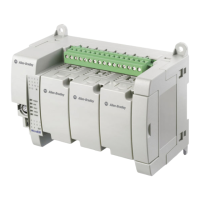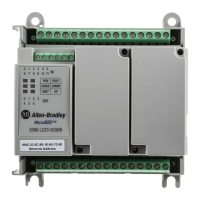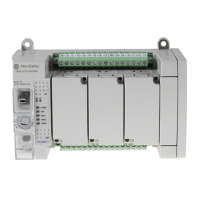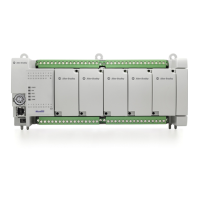Publication 1766-RM001A-EN-P - October 2008
140 Using High-Speed Outputs
• Accelerate/decelerate intervals
• Run interval
The PTO instruction, along with the HSC and PWM functions, are
different than most other controller instructions. Their operation is
performed by custom circuitry that runs in parallel with the main system
processor. This is necessary because of the high performance
requirements of these functions.
In this implementation, the user defines the total number of pulses to be
generated (which corresponds to distance traveled), and how many
pulses to use for each acceleration/deceleration period. The number of
pulses not used in the acceleration/deceleration period defines how many
pulses are generated during the run phase. In this implementation, the
accelerate/decelerate intervals are not required to be the same.
Independent values can be defined for these intervals. The ADI bit in the
PTO function file is used to enable this feature. See page 144.
Within the PTOX function file, there are PTOX element(s). An element
can be set to control either output 2 (O0:0/2 on 1766-L32BXB or
1766-L32BXBA), output 3 (O0:0/3 on 1766-L32BXB or 1766-L32BXBA) or
output 4 (O0:0/4 on 1766-L32BXB or 1766-L32BXBA)
The interface to the PTO sub-system is accomplished by scanning a PTO
instruction in the main program file (file number 2) or by scanning a PTO
instruction in any of the subroutine files. A typical operating sequence of
a PTO instruction is as follows:
1. The rung that a PTO instruction is on is solved true.
2. The PTO instruction is started, and pulses are produced based on
the accelerate/decelerate (ACCEL) parameters, which define the
number of ACCEL pulses and the type of profile: s-curve or
trapezoid.
3. The ACCEL phase completes.
4. The RUN phase is entered and the number of pulses defined for
RUN are output.
5. The RUN phase completes.
6. Decelerate (DECEL) is entered, and pulses are produced based on
the accelerate/decelerate parameters, which define the number of
DECEL pulses and the type of profile: s-curve or trapezoid.
7. The DECEL phase completes.
8. The PTO instruction is DONE.
efesotomasyon.com - Allen Bradley,Rockwell,plc,servo,drive

